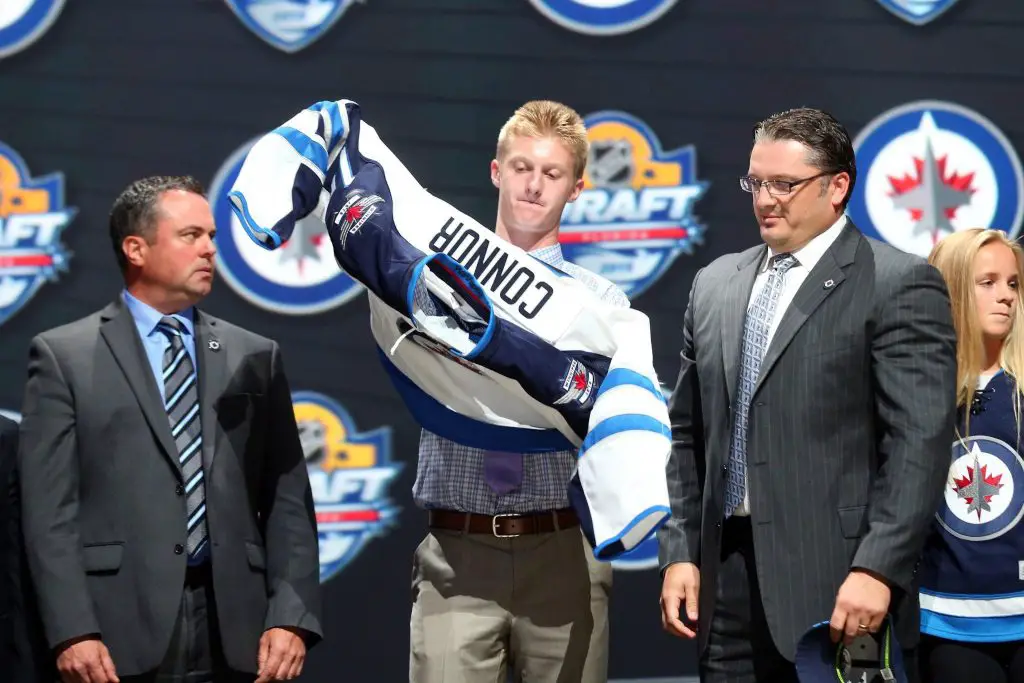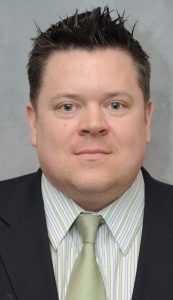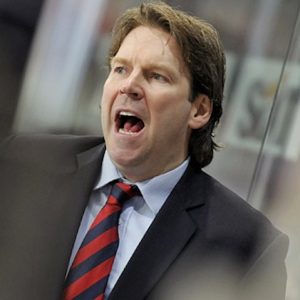
Recruiting is the lifeblood of college hockey.
For its professional counterpart, the basis for any franchise begins with scouting.
The 2021 NHL Draft will be conducted virtually this weekend, the culmination of over a season’s worth of countless individuals scouting games across North America and Europe, trying to determine the next clutch of players to perhaps one day be good enough to don an NHL sweater.
Denver assistant coach Tavis MacMillan, a former player and coach at Alaska Fairbanks, scouted for the Atlanta Thrashers from 2007 to 2011. He then stayed with the franchise for four more seasons when it relocated to Manitoba to become the new Winnipeg Jets.
Macmillan came to scouting after serving as an assistant coach at UAF from 1996 to 2003, and then as head coach from 2004 to 2007. He had just signed an extension to stay with the Nanooks when he decided to relocate his young family to Minnesota, to further his wife’s advancing career. Hopeful of staying in hockey, he got some help from his old college coach.
“Don Lucia gave me a scholarship—and then he got me a job,” chuckled MacMillan, who then went to work for the Thrashers as their Minnesota-area scout.
Having been a coach himself in the past only aided MacMillan’s scouting efforts.
“It helped immensely, and it gave me perspective,” admitted the Milk River, Alberta native.
He said that sometimes, one can get stuck on the proverbial “eye test” in watching players and their in-game performance. With a coaching background, however, they may be more apt to notice certain things players are doing, or are supposed to be doing, within a team framework, rather than simply showcasing their individual skills.
“I became a better scout from coaching, and a better coach from scouting,” said MacMillan. “The more disciplines involved, they make you better at your job.”
He also worked as a crossover scout in his last few years in the NHL. He would observe a list of players from outside his normal scouting zone, to offer his assessment of those prospects, with the observances coordinated by the team’s area scout.
“They know those players better than you ever will,” said MacMillan.
With Atlanta, he also served as an area scout in Minnesota, where he was responsible for creating a list of players to be scouted.
“You sort it out and do your homework,” he said, although the top players are generally known to everyone these days. “There’s not as much ‘diamond in the rough’ anymore.”
For amateur scouts based in the United States, who are often tasked to attend various showcases and tournaments in addition to regular league games, MacMillan said they can view anywhere from 225 to 275 contests in a given season. He also admitted that being a scout entails all the perceived trappings of racking up air miles, hotel points, and car rentals, in searching for the next hopefully “can’t miss” prospect.
His travels also involved time away from home, which for MacMillan meant some months where he was away from his wife and three daughters for over 20 days or so. Sometimes he would head out west for 10 days to scout players, return home for a few days, and then repeat that cycle. There were also European trips, some of which could last as many as 14 days at a time.
“That’s the job,” said MacMillan. “You’ve got to see games.”
MacMillan said he also learned as a scout to value more intangible traits in players.
He cited high-scoring forward Brayden Point of the back-to-back Stanley Cup champion Tampa Bay Lightning as an example. Point’s skating might not have been up to perceived NHL standards in his draft year, but MacMillan said Point has made up for that shortcoming with his on-ice intelligence, anticipation, and compete level.
“You can get blinded by the eye test and miss some stuff, or overvalue some things,” said MacMillan. “I’ve learned over time to appreciate hockey sense and competitiveness.”
In a normal season, the NHL Draft is held in June in one of its member cities. A team’s final prospect list, however, is set well before the event actually arrives.
“In my experience, we worked hard to put that list together,” said MacMillan. “Our final meetings were done in May.”
To tinker with that prepared list by, say, pushing hard for a particular player leading right up to the draft would be “dangerous,” as he put it, especially since a team’s scouting staff spends an entire year compiling and refining it.
“To change it would be a shame,” said MacMillan, unless something “earth-shattering” occurred.
Even with the list set, team scouts still do their homework. A week or so before the draft, they may meet with up to a dozen top prospects to interview them again on a 1-on-1 basis. Still, no major changes are usually made in a club’s approach at that point.
“Everyone feels a part of it,” he said of the club’s final prospect list. “In my experience, it stayed pretty consistent.”
He added that he had also been fortunate to work for general managers and assistant general managers who let their scouts do their jobs.
Sometimes, scouting can be more akin to spying when it comes to certain players, players that one NHL club may value far more than their competitors do.
“You hold your cards pretty close to the vest,” said MacMillan of those instances. “You don’t want to tip your hand.”

One such bit of skullduggery involved current Winnipeg netminder Connor Hellebuyck, who backstopped UMass Lowell to the 2013 NCAA Frozen Four before turning pro. MacMillan recalled scouting the draft-eligible Michigan native when he was playing his lone season (2011-12) in the North American Hockey League.
“I saw him,” said MacMillan, “but I didn’t want anyone to see me.”
MacMillan said he “morphed into the stands” by not wearing any identifying Jets logos, not even carrying a pen and paper for notes.
“You go incognito, so to speak,” said MacMillan of those extreme situations.
Winnipeg went on to select Hellebuyck 130th overall that year. He won the Vezina Trophy as the NHL’s top goaltender in 2020.
MacMillan left the Jets in 2015 to join Denver’s coaching staff, and two years later he helped the Pioneers to their first NCAA title in a dozen campaigns. Now it’s NHL scouts who contact him, to get the skinny on his current players.
“I’m on the other side now,” he said.
MacMillan’s former linemate at Alaska Fairbanks, Dean Fedorchuk, led the NCAA in scoring in 1993-94 with 74 points, which tied him with MacMillan that season. Fedorchuk was also a top 10 finalist for the Hobey Baker Memorial Award that year.
After retiring in 2008 after skating over a dozen seasons in Europe, specifically Germany and Denmark, Fedorchuk coached in those two countries over the next three years before joining Winnipeg as a scout for two seasons, first as a European scout and then as a pro scout. For the Winnipeg native, it was a chance to connect with the newest incarnation of his boyhood team.
“When Winnipeg came back to the NHL, it was a wonderful opportunity to live out a childhood dream,” he admitted. “It was the team I used to listen to on the radio as a kid, and I just wanted to put my name in there. It was a great opportunity, and pretty fun.”
As with MacMillan, Fedorchuk believes that previous experience in coaching hockey can enhance one’s efforts in scouting players.
“I think there’s great synergy between the two,” said Fedorchuk, who has spent most of the last eight years coaching in Croatia and Switzerland. “You’re looking at players, and you think ‘I’d love to have that guy play for me.’ The coach in you comes out, and sometimes even the player, seeing someone you would have loved to have had as a teammate.”
He noted that at the end of the day, scouts fill out reports on how a player might potentially excel one level higher, by rating them on physical skills such as skating, up to how hard they battle on the ice.
“There’s key things you’re looking for with forwards, and key things with defensemen,” said Fedorchuk, “and then there’s the intangibles and other things for (ranking) players.”
As a pro scout for the Jets in Europe, Fedorchuk related that he didn’t scout the junior leagues there, as he was looking for more than the standard youthful prospects.
“It was two-fold,” he said. “I was looking for free agents, guys probably between 21-25, as prospects for the NHL.”
He would still seek out draft-eligible players in the pro leagues, though.
“I’d give a recommendation on them as well,” he said. “It was sort of the best of both worlds.”
He also saw a rise in European players who started to view American college hockey as a viable path to the NHL, and today’s NCAA game has seen a sizable influx of European talent.
“I started to get a sense that more European players were interested in the college route,” said Fedorchuk. “They have very good university packages and socialized government (at home), whether they play hockey or not—and now there are opportunities for athletes from Scandinavia, Germany, Latvia, etc., who are exposed to the college route.”
He also said there had been a lessening of the grip of family and advisors back home on such players, to let them play in North America. Places like Sweden have even hosted camps for skaters seeking to play in the NCAA.
“There’s more opportunity for Europeans to jump in, for sure,” said Fedorchuk, who remains UAF’s all-time leading goal-scorer with 113 tallies.
A player who has made the transition from Europe to the NCAA to the NHL recently is Minnesota Wild forward Nico Sturm. Sturm played his formative hockey in his native Germany, traveled to North America to play juniors, and then skated three seasons with Clarkson University before signing with the Wild as a free agent and becoming a fixture in its lineup.
During his tenure with the Jets, Fedorchuk believed that he viewed some 20-25 games per month, and perhaps several more when attending tournaments. His European scouting season usually began in mid-August with observing training camps, and would conclude at the end of May with the World Championships.
Fedorchuk, who returned to Fairbanks in the summers for many years to work ALCAN Hockey camps there, also said he was never more than 7-10 days away from his family at a time during his scouting days.
“I had a lot of autonomy to make my own schedule,” he admitted.
Headquartered in Malmo, Sweden, he would often venture to places like Stockholm to watch the Swedish league, Helsinki to view the Finnish league, and Latvia to observe the Kontinental Hockey League.
“I could see a game every night when I wanted to,” he said, “and travel was inexpensive and simple.”
He would sometimes take a train or plane from Helsinki to Riga, Latvia some 245 miles away, and spend time in hotels at both sites, going back and forth between the two cities when he was not at their rinks looking for talent.
“The biggest thing was the players you wanted to see, in making the optimal schedule,” said Fedorchuk.
Besides Riga, he also scouted in such capital cities as Prague in the Czech Republic, and Bratislava, Slovakia. He called them “beautiful cities” with great infrastructure, and added that they often gave him more opportunity to scout players, in less crowded environments than some other stops.
Fedorchuk also explained that, early on in Winnipeg’s second NHL tenure, the Jets general manager had come from the Chicago Blackhawks system, and his interest was in building the “new” Jets through the draft.

“There was a big focus on that,” said Fedorchuk, of selecting the best players available at the time.
College players, or players headed to college, who heard their name called by Winnipeg at subsequent NHL Drafts included Jacob Trouba (Michigan), Andrew Copp (Michigan), Kyle Connor (Michigan), Jack Roslovic (Miami), Mason Appleton (Michigan State), Dylan Samberg (Minnesota Duluth) and Nathan Smith (Minnesota State).
Fedorchuk said that, with the salary cap and its constraints, NHL teams nowadays often look to fill out their rosters with European free agents. Those players, who are perhaps in their older 20s, are usually signed for under $1 million or so apiece, which allows most clubs to still pay the huge salaries of their core stars.
“It’s a huge shift now,” he said.
NHL scouts are usually tasked with looking for players in all three basic positions of the game—but at least one club employs an individual who looks solely at potential puck-stoppers, sort of in the “it takes one to know one” category.
Former Nebraska Omaha and NHL netminder Dan Ellis has served as the pro and amateur goaltending scout for the Chicago Blackhawks since 2017. Drafted in the third round (60th overall) by the Dallas Stars in 2000, he then backstopped UNO for three seasons, winning 53 games before going on to a 10-year NHL career with Dallas, Nashville, Tampa Bay, Anaheim, Carolina and Florida where he recorded 87 wins and 15 shutouts.
Asked if he might have scouted/selected himself as a player now, Ellis noted that the goalie game has changed in the last 20-plus years, and he might not hear his name called today.
“My style was a lot different back then,” he related.
The Saskatoon native explained that he spent a lot of time on his stomach, in comparison to today’s largely butterfly-style netminders that he and other scouts spend so much time scrutinizing.
“You pick apart what makes them successful, and what could be successful in the NHL,” said Ellis.
By today’s standards, bigger goaltenders tend to have the best shot at becoming No. 1 NHL netminders.
“Six-foot-two (in height) usually translates to a number-one goaltender,” said Ellis. “They cover a little more net. There’s a few more (shooting) openings in smaller goaltenders.”
To Ellis, though, it doesn’t necessarily matter where draft-eligible amateur goaltenders ply their trade.
“I don’t know if it’s a disadvantage to play in college,” said the former NCAA netminder. “It’s four years of development, with some older players.”
Although goalies in the Canadian Hockey League might play 60 or more games in a given year, which more readily imitates a pro-style schedule, Ellis noted that college players have the opportunity to hit the gym and improve under the eyes of school strength staff.
“It’s a little bit longer timeline for some teams,” he said, regarding college-trained goaltenders turning pro.
He also keeps tabs on European netminders, including prospects who might one day choose to play U.S. college hockey.
“My goal in general is to give us the best goaltending depth in the NHL,” said Ellis. “That’s how I approach it every day, at every single level—to secure a bright future for years to come.”
Scott Fitzgerald, director of collegiate scouting for the Boston Bruins, played junior hockey with former NHL and Boston College forward Bill Guerin, now GM of the Minnesota Wild. Fitzgerald related that the Bruins technically have two college scouts, in himself and former Bowling Green center Brett Harkins, who piggyback their efforts off of the franchise’s other amateur scouts.
Boston’s general manager the last six years has been former Harvard and Bruins blueliner Don Sweeney.
“I’m the sign-off guy,” said Fitzgerald, of compiling the club’s college prospects list. “I bring it to Don, to see what he needs, and narrow it down to who we really like.”
Besides examining current college players who might still have NHL draft eligibility, Fitzgerald also makes pitches to older college free agents, which he said occurred more in the past year with COVID-related restrictions, including travel across the U.S.-Canadian border.
“It was a goofy year, for sure,” he said.
Fitzgerald regularly scouts Atlantic Hockey, ECAC Hockey and Hockey East schools during the season. Atlantic Hockey features four New England schools in AIC, Bentley, Holy Cross and Sacred Heart, which he said provides “a good starting point,” along with the Beanpot schools. He also believes that the college route to pro hockey provides more structure, with the common arrangement of skating several practices during the week followed by two games on the weekend.
“There’s more time to work out, and less time on buses,” said Fitzgerald. “It’s been very successful lately, and a lot of kids are leaning towards the college route. College is a global game now.”
He also said that college hockey is a step closer to the NHL, with the American Hockey league being the closest, although some NCAA players can graduate directly to the NHL now.
“It’s a really good development league,” he said of the NCAA, with teams holding players’ rights for four years, allowing collegians more time to mature.
With the Bruins, any scouts viewing college players are tasked/chained to the amateur side in assembling the team’s potential draft list. Players are “slotted in,” as compared to their counterparts playing in high school or the CHL, along with recommendations on what round to take a player in, should he still be available when Boston’s turn comes at the draft board.
“We get a good book on everyone in college,” said Fitzgerald. “We basically want to know everyone in college.”
Besides assembling prospects for the parent club, potential picks might include those who could be considered for trade talks.
“Everyone has college prospects,” said Fitzgerald, brother of New Jersey Devils GM and former Providence forward Tom Fitzgerald, and uncle to former Boston College skaters Casey and Ryan Fitzgerald.
He added that most clubs have a dedicated college scout or two who help provide GMs with the proper data to build the so-called book, especially with the NHL Draft now comprised of just seven rounds in all.
“There’s more free agents, and it’s more of a global game,” said Fitzgerald. “It’s an important part of team building.”



